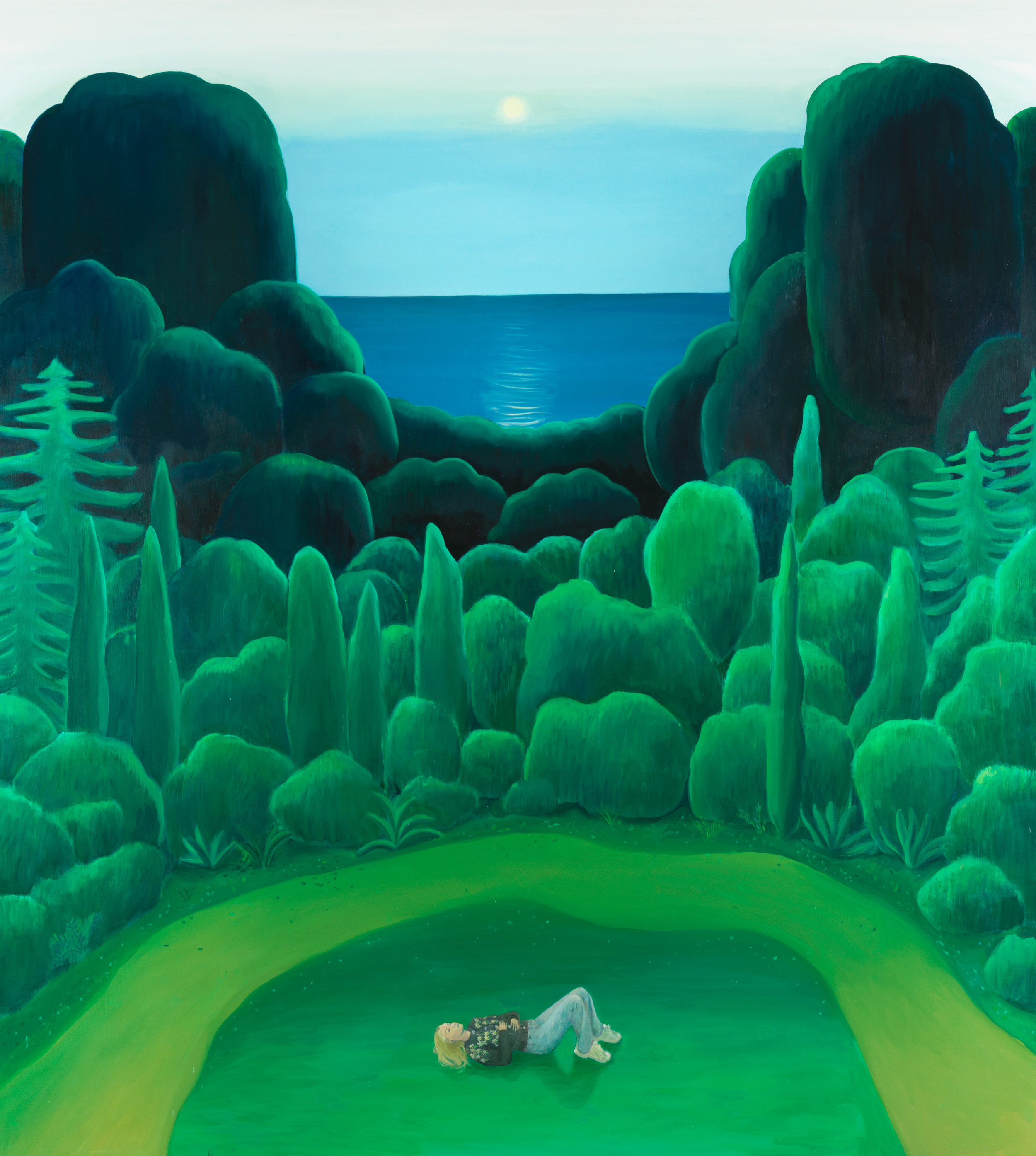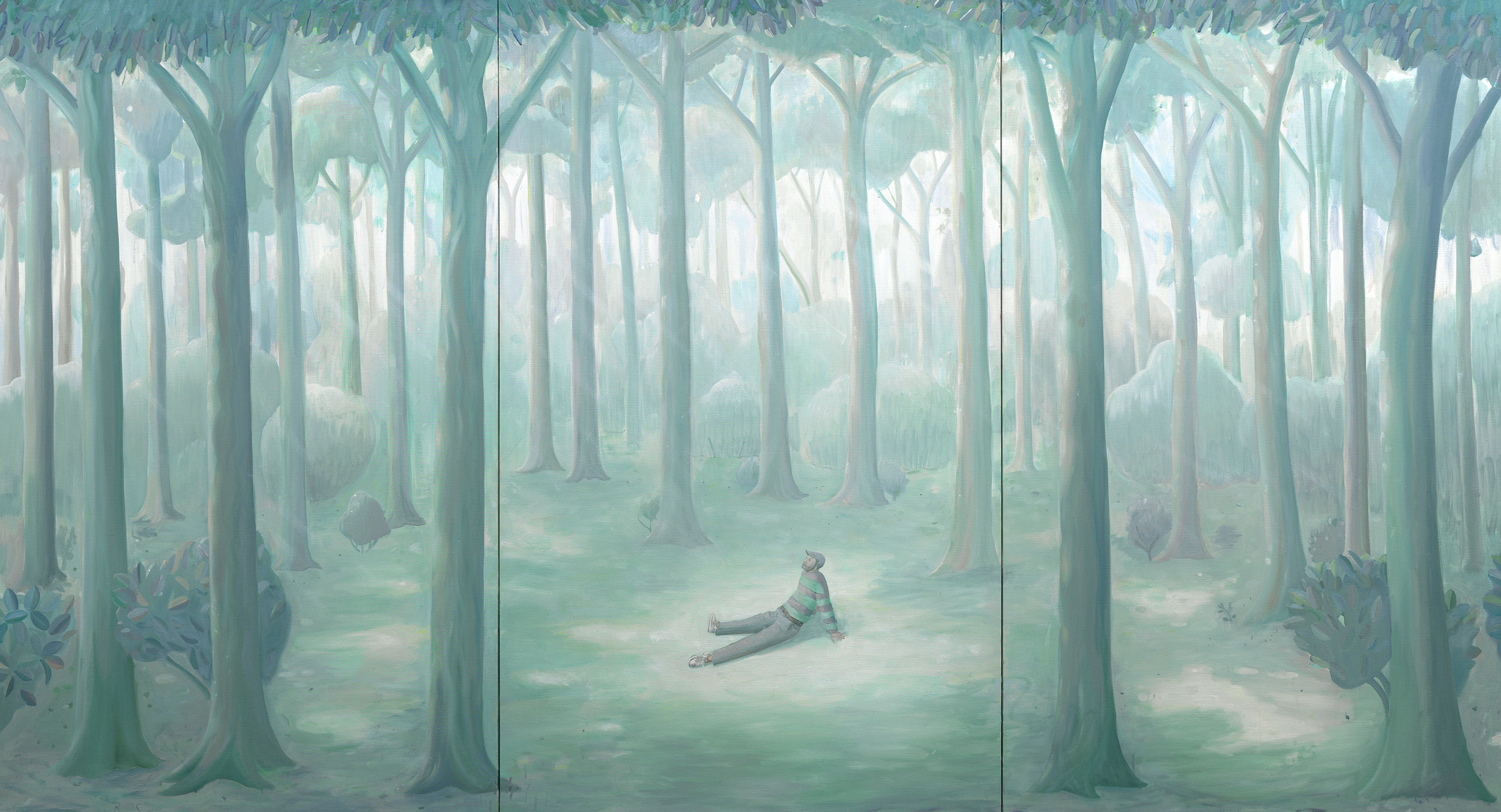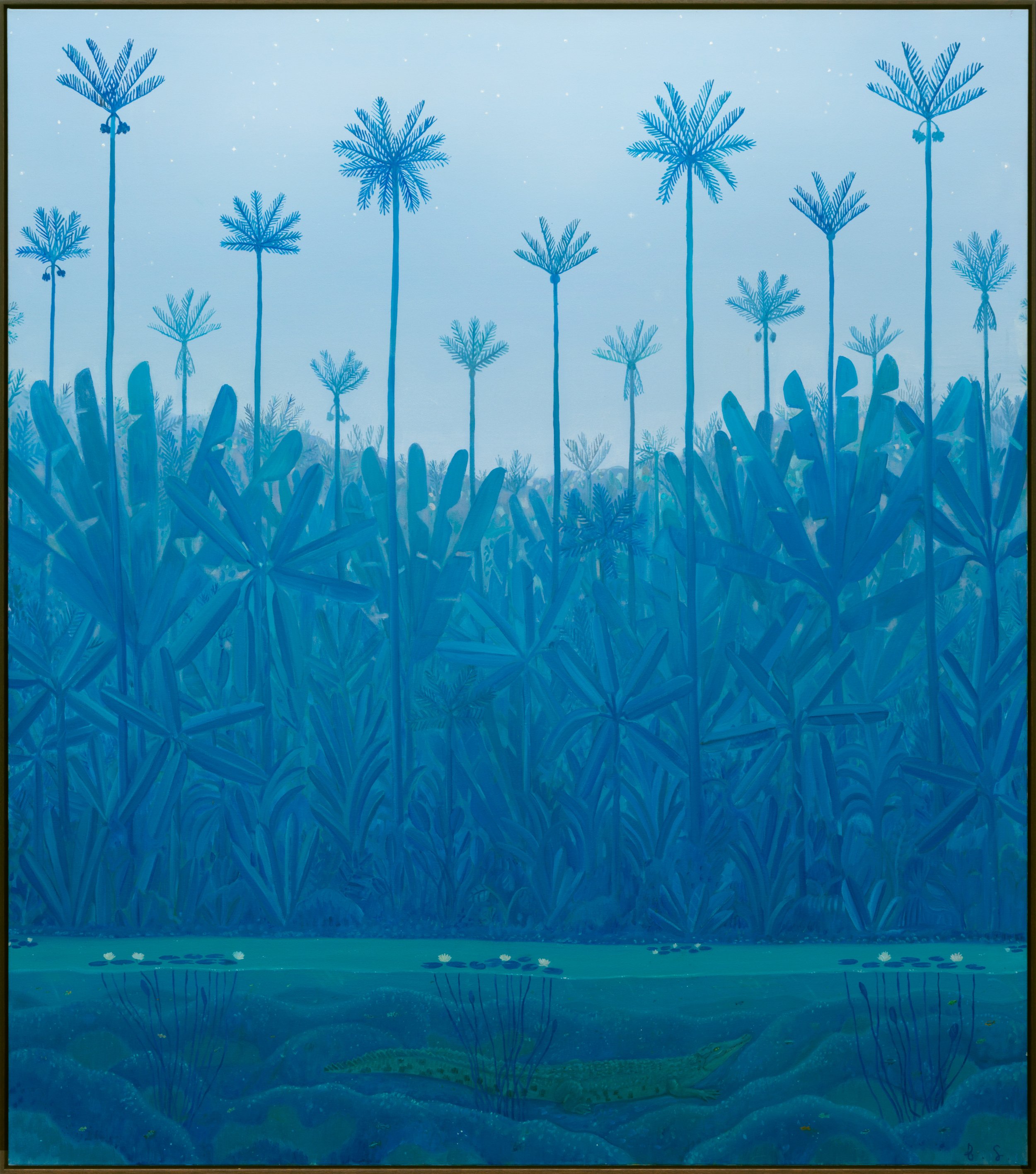
January 2024
Ben Sledsens
Detail, Ben Sledsens, Green Garden, 2023, oil and acrylic on canvas, 75 x 67 inches
Camilla Boemio speaks with the young Belgian painter about art, nature, and his new exhibition at Tim Van Laere Gallery in Rome.
Ben Sledsens’ (Antwerp, b.1991) paintings seem to open as their own slices of paradise and mysterious scenarios in which the landscape becomes the main protagonist at Tim Van Laere’s new gallery conquers the Roman art scene. In the historic Palazzo Donarelli Ricci located at Via Giulia 98 in Rome, Tim Van Laere Gallery opened its new space on November 18, 2023. The exhibition’s title, Un Nuovo Viaggio, is an allusion by the artist to a new chapter in his own practice, but also in that of the gallery.
Sledsens’ oeuvre offers a glimpse into his imaginary world, a utopia in which he wants to live himself. His carefully constructed compositions and their vibrant color palette open up to the viewer’s eyes and invite them to explore the unexplored world of his imagination.
In 2015, Sledsens received the KoMASK Award for painting, presented by Belgium’s Royal Society for the Encouragement of Fine Arts. Trained at the Royal Academy of Fine Arts Antwerp, Sledsens draws on the visual language of Henri Rousseau, Henri Matisse, Pieter Bruegel, and Pierre Bonnard. His paintings are in the permanent collections of institutions like the Museum of Contemporary Art Antwerp; Museum of Contemporary Art San Diego, San Diego, USA; The State Hermitage Museum, Saint Petersburg, in Russia; Fundación Canaria para el Desarrollo de la Pintura in Spain and CAC Malaga.
Congratulations on your exhibition at Tim Van Laere Gallery in Rome. How did you select the work for the show?
I never work towards a show, but I work from one work to another; that way, a certain work inspires me to start another. Once I have a number of pieces and the upcoming show, I select the works to be displayed in the space. The works must interact with each other; this can be based on color and the roads or characters depicted.
At the beginning of your career, you painted scenes taken from contemporary life but have since expanded to explore sublime scenery and a more allegorical approach. This often takes viewers into a forest or the night. It’s like a mystical attitude in which we are oriented in a state of sublime devotion to this landscape. Did Paolo Uccello’s paintings influence your practice?
I have not looked extensively at painters from the Italian Renaissance but instead find myself influenced by artists who, in turn, may have drawn their inspiration from these Italian masters. While there may not be a direct influence, there is an indirect exchange of inspiration between artists.
As for the allegorical or folkloristic aspect of my work, I believe that this narrative dimension comes unintentionally from my childhood, where fables and mythology played a role. I have vivid memories of my grandfather reading me bedtime stories, which left a lasting impression. As a kid, I was fascinated by nature, the animals inhabiting it, as well as knights. For me, childhood represents some kind of purity; where I would listen carefully to stories such as The Fox and the Raven, in which those animals have human emotions that are magnified, to create a kind of archetype that conveys a moral message. It is this attribution of human qualities or characteristics to animals that really intrigues me.

Detail, Ben Sledsens, A New Light, 2023, oil and acrylic on canvas, 71 x 130 inches
Art history and our present are perfectly balanced in the context. It seems to find the secret to moving the present and the past with suggestions and powerful colors.
Art history is my primary source of inspiration since I think through images more than words. The images offer me an alibi to be sincere and engage with that history in my own way, allowing me to create a personal world in which the present and the past blend together. In this way, I combine a modern or contemporary aspect of our world with art historian references and a world of mine.
Ben Sledsens, Un Nuovo Viaggio, 2023, oil and acrylic on canvas, 71 x 63 inches
How do you depict nature without getting trapped in endless greens?
I wouldn’t have a problem with depicting nature as “endless green” because you have endless possibilities in that as well. This is what Rousseau was doing. I sometimes chose monochromatic shades, only I try to translate the greens into other colors, since in painting there are no rules, I choose them myself. Colors in landscapes (rose, blue, purple) can also suggest a particular moment or landscape. For instance, Monet not only used shades of green for his landscape, but he also used shades of purple, rose, or orange to allow the landscape to indicate his individuality. Landscapes change color (a landscape in the morning light with fog is more likely to be red or purplish); through the seasons, this same landscape can take on a completely different hue. Red can reflect a sunset, yellow depicts a more Mediterranean setting, and blue is more like a cold and early night. Color sets the mood.
Ben Sledsens, Beneath the Surface, 2022—2023, oil and acrylic on canvas, 71 x 63 inches
Please tell me about the subjects you often insert in these scenes.
The characters in my work tell a story that raises questions for the spectator. This narrative is supposed to maintain a certain openness, allowing the viewer to interpret it. There is a certain tension and mystery in the landscapes; I like to build compositions around instances of climax, where the scenes appear to capture the moments before and after the ones depicted. That creates a moment that engages the viewer in the painting. Sometimes, my characters are merely figurants in a dominating landscape, with the landscape acting as the protagonist. At other times, they are the protagonists.
Ben Sledsens, Figure in the Yellow Garden, 2023, oil and acrylic on canvas, 71 x 55 inches
“I like to build compositions around instances of climax, where the scenes appear to capture the moments before and after the ones depicted.”
Ben Sledsens, Night Fishing, 2022—2023, oil and acrylic on canvas, 59 x 63 inches
What is your process like for crafting your paintings?
I prefer not to paint in series; the works arise simultaneously and interact. I work a lot and usually start by making sketches before working on the canvas. I also always begin with acrylic paint because this allows me to work quickly since it dries fast. With this kind of paint, there are few rules, and as soon as the composition is right, I start painting with oil. My paintings are composed of many layers, which you may not see at first glance. The images may change during the process so that they remain interesting. Underneath the final work, there are actually other paintings and compositions. Though the works seem very finished, beneath them are many other layers and changes, such as a character changing places and a tree that becomes a different one.
Installation view, Ben Sledsens, Un Nuovo Viaggio, Tim Van Laere Gallery, Rome, November 18, 2023 - February 3, 2024
Installation view, Ben Sledsens, Un Nuovo Viaggio, Tim Van Laere Gallery, Rome, November 18, 2023 - February 3, 2024
Installation view, Ben Sledsens, Un Nuovo Viaggio, Tim Van Laere Gallery, Rome, November 18, 2023 - February 3, 2024
Portrait of Ben Sledsens courtesy Tim Van Laere Gallery, Antwerp-Rome
Ben Sledsens
Un Nuovo Viaggio
Tim Van Laere Gallery
Rome
November 18, 2023 - February 3, 2024
Camilla Boemio is an internationally published author, curator, and member of the AICA (International Arts Critics) based in Rome. In 2013, Boemio was the co-associate curator of PORTABLE NATION: Disappearance as Work in Progress – Approaches to Ecological Romanticism, the Maldives Pavilion at the 55th International Art Exhibition La Biennale di Venezia. In 2016, Boemio curated Diminished Capacity, the First Nigerian Pavilion at the Venice Architecture Biennale. Boemio’s recent curatorial projects include her role as co-associate curator at Pera + Flora + Fauna. The Story of Indigenousness and The Ownership of History, an official collateral event at the 59th International art exhibition La Biennale di Venezia, 2022. Invitations to speak include the Tate Liverpool, MUSE Science Museum, and the Cambridge Festival 2021 at Crassh in the UK.







